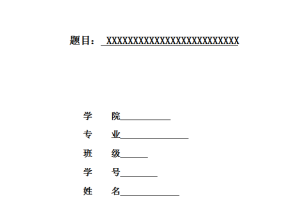摘 要
网络的空前发展给人们的工作和生活带来了极大的便利,信息技术已成为节约运营成本、提高工作效率的首选。相比之下,国内相当多的中小医院在医院预约工作中的手工工作比较保守,数据查询和存储成本都很高,但效率很低。为了使医院预约挂号管理更加高效、更加科学,决定开发医院预约挂号平台。
本文采用结构化分析的方法,详细描述了一个功能比较强大的医院预约挂号平台开发前后的操作流程以及台湾涉及的一些关键技术。我们进行了可行性分析和系统分析的方法,通过实际的业务流程调研,分析业务流程和系统的组织结构,完成了数据流分析和数据字典;然后是系统设计阶段主要完成了功能模块的划分,阐述了设计的工具和技术与设计,数据库设计系统。在系统功能模块详细设计阶段,形成系统功能图。首先对数据库进行概念设计、结构设计、逻辑设计之后,最后完成了数据表的设计。
根据前几个阶段的分析和设计,本系统采用B/S模式设计,同时利用JSP技术进行基本页面的设计与实现,后台数据库采用SQL Server 2000数据库。本系统的设计与实现是医院预约挂号系统的基础。
关键词:挂号;结构化分析;平台
The unprecedented development of the network has brought great convenience to people’s work and life, information technology has become the first choice to save operating costs and improve work efficiency. In contrast, quite a number of domestic small and medium-sized hospitals in the hospital appointment work manual work more conservative, data query and storage costs are high, but the efficiency is very low. In order to make the hospital appointment registration management more efficient, more scientific, decided to develop hospital appointment registration platform.
In this paper, the method of structural analysis, a detailed description of a more powerful function of the hospital appointment registration platform before and after the operation of the development process and some of the key technologies involved in Taiwan. We carried out a feasibility analysis and system analysis method, business process through the actual research, analyze business processes and organizational structure of the system, complete the data flow analysis and data dictionary; and then completed the system design phase is mainly divided into functional modules, expounds the design tools and technology and design, database design system. In the detailed design stage of the system function module, the system function diagram is formed. First of all, the concept design, the structure design and the logic design of the database are finished.
According to the first few stages of the analysis and design, the system uses B/S mode design, while the use of JSP technology for the design and implementation of the basic page, the background database using SQL Server 2000 database. The design and implementation of the system is the foundation of the hospital appointment registration system.
Key words: registration; structural analysis; platform
目 录
摘 要……………………………………………………………………………………………………………….. I
Abstract……………………………………………………………………………………………………………….. II
一、引言…………………………………………………………………………………………………………….. 1
(一)项目开发的背景……………………………………………………………………………….. 1
(二)项目开发的目的……………………………………………………………………………….. 1
二、可行性分析及总体设计原则……………………………………………………………………………. 2
(一)可行性分析………………………………………………………………………………………. 2
1.技术可行性……………………………………………………………………………………………. 2
2.经济可行性……………………………………………………………………………………………. 2
3.社会可行性……………………………………………………………………………………………. 3
(二)总体设计原则…………………………………………………………………………………… 3
三、系统分析………………………………………………………………………………………………………. 5
(一)业务流程分析…………………………………………………………………………………… 5
(二)数据流图………………………………………………………………………………………….. 6
(三)数据字典………………………………………………………………………………………….. 9
四、系统设计…………………………………………………………………………………………………….. 13
(一)系统功能设计…………………………………………………………………………………. 13
(二)系统数据库设计……………………………………………………………………………… 14
1.概念结构设计………………………………………………………………………………………. 14
2.逻辑结构设计………………………………………………………………………………………. 18
3.数据库表设计………………………………………………………………………………………. 18
(三)系统开发工具与开发模式的选择…………………………………………………….. 20
1.系统开发工具………………………………………………………………………………………. 20
2.系统设计模式………………………………………………………………………………………. 21
五、系统实现…………………………………………………………………………………………………….. 22
(一)用户模块………………………………………………………………………………………… 22
1.登录及注册管理模块……………………………………………………………………………. 22
2.首界面…………………………………………………………………………………………………. 23
3.用户注册界面………………………………………………………………………………………. 24
4.公告界面……………………………………………………………………………………………… 25
5.科室预约界面………………………………………………………………………………………. 26
6.留言界面……………………………………………………………………………………………… 27
(三)管理员模块…………………………………………………………………………………….. 28
1.登录界面……………………………………………………………………………………………… 28
2.科室管理界面………………………………………………………………………………………. 28
3.添加专家界面………………………………………………………………………………………. 29
六、性能测试与分析…………………………………………………………………………………………… 30
(一)测试的重要性…………………………………………………………………………………. 30
(二)测试实例的研究与选择…………………………………………………………………… 30
(三)测试环境与测试条件………………………………………………………………………. 31
(四)实例测试………………………………………………………………………………………… 32
(五)系统评价………………………………………………………………………………………… 32
(六)测试结果………………………………………………………………………………………… 33
参 考 文 献……………………………………………………………………………………………………….. 35
致 谢…………………………………………………………………………………………………………….. 36





